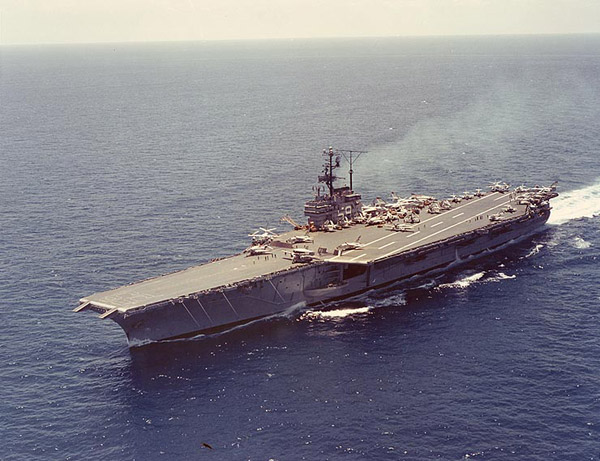Forrestal-class
Summary
| Origin country | 🇺🇸 United States |
| Category | Aircraft carrier |
| Subtype | Fleet carrier |
| Manufacturer | New York Navy Yard, Newport News Shipbuilding |
| Year commissioned | 1955 |
Description
The Forrestal-class aircraft carriers, designed and constructed for the United States Navy in the 1950s, represented the first generation of supercarriers. These vessels were named after James Forrestal, the inaugural United States Secretary of Defense. These supercarriers were distinguished by their substantial tonnage, the introduction of deck-edge elevators, and the incorporation of an angled deck. The first Forrestal-class ship was commissioned in 1955, and the last was decommissioned in 1998. All four carriers of the class were ultimately dismantled in Brownsville, Texas, between 2014 and 2017.
The Forrestal-class carriers marked a considerable enlargement over their predecessors, with their design boasting approximately 75,000 tons—25% larger than the Midway class. The design included a fully integrated angled deck, a substantially sized island, and the capacity to support a formidable air wing comprising 80–100 jet aircraft. This design allowed better aircraft operations, contributed to a stronger and lighter hull structure, and improved seakeeping capabilities compared to the older Midway class that exhibited poor sea keeping and aviation characteristics.
Despite their advancements, the Forrestal-class carriers had their flaws. The elevator configuration was suboptimal for aircraft movements. Notably, the portside elevator was positioned at the forward end of the angled deck, interfering with both launch and recovery operations. The sponson-mounted gun arrangements were also less effective and were removed within a few years, with missile systems and later CIWS installations taking their place. Further modifications in design improved upon these early issues, with later vessels like the Kitty Hawk class addressing the problematic portside elevator and island positions.
Operational history of the Forrestal class varied, with several iterations and modifications taking place during their service. The first pair, Forrestal and Saratoga, had an original design that was altered during construction from axial to angled deck carriers. Ranger and Independence, following the initial two, incorporated minor improvements and distinctive features such as a single island mast and a more enclosed fantail design.
In the realm of international naval operations, nearly at the end of the 20th century, the US offered one of the Forrestal-class carriers to Brazil. However, this offer was declined due to the high operational costs, and Brazil opted for the French carrier Foch instead. Eventually, all the Forrestal-class carriers were struck from the Naval Vessel Register and have been scrapped, marking the end of their naval service history.
Technical specifications
| Displacement | 60000 tons |
| Crew | 4,378 members |
| Width | 73.0 m (239.5 ft) |
| Length | 326.1 m (1069.9 ft) |
| Air Park | 10 F-14D Tomcats, 36 F/A-18C/D Hornets, 4 E/A-6B Prowlers, 4 E-2C Hawkeyes, 8 S-3B Vikings, 2 C-2A Greyhounds, 7 SH-60F/H Seahawks |
| Propulsion | 4 Westinghouse electric motors with a total power of 280,000 hp - 4 propellers |
| Armament | 3 Sea Sparrow Mk-29 launchers + 3 Phalanx CIWS Mk-15 20 mm |
| Maximum speed | 34 knots |
